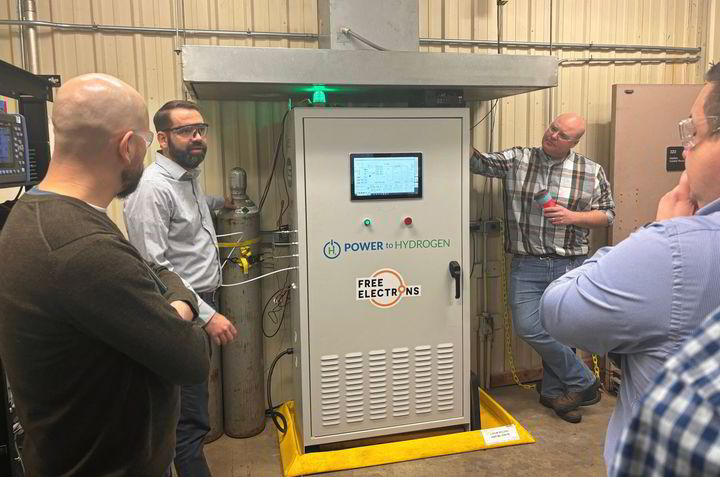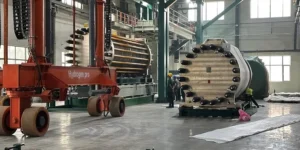US start-up backed by Shell, Amazon and Nasa unveils ‘first ever industrial-scale AEM electrolyser for low-cost green hydrogen’

A US start-up backed by Shell, Amazon and Nasa has unveiled what it describes as the “first ever industrial-scale anion-exchange-membrane [AEM] electrolyser stack for low-cost green hydrogen”, ahead of an industrial-scale pilot project later this year.
Ohio-based Power to Hydrogen (P2H2) says it has successfully demonstrated a fully integrated electrolysis system using its AEM stack at a pilot facility in Columbus, Ohio, belonging to partner American Electric Power (AEP) — in conjunction with three European utilities: Portugal’s EDP, Germany’s E.ON and Ireland’s ESB.
“The system demonstrated the ability to react quickly to load changes and produce hydrogen more efficiently than any renewable load-following product on the market,” said P2H2, adding that its patented technology has higher performance and durability than conventional AEM electrolyser designs.
AEM electrolysers are often described as a cross between alkaline and proton-exchange-membrane (PEM) electrolysers, with all the benefits of both, but none of the downsides.
So AEM machines share PEM’s ability to quickly ramp up and down in response to variable wind and solar power, but without the need for the expensive platinum and iridium required by PEM, giving it similar costs to alkaline electrolysers, but with greater efficiency. (Note: manufacturers of pressurised alkaline electrolysers say the same about their technology.)
However, AEM is a relatively new technology that is yet to reach broad commercial acceptability, despite the best efforts of AEM market leader Enapter. Germany’s Sunfire, which today announced more than €500m of new financing, is also developing new AEM technology in collaboration with Canada’s Ionomr Innovations, and US start-up EvolOH is building a 3.75GW AEM electrolyser factory in Massachusetts (see below).
Article continues below the advert
P2H2 declined to tell Hydrogen Insight the size of the new electrolyser stack, but said it was developing electrolyser modules in the “hundreds of kilowatts” range — and a series of images made available to Hydrogen Insight suggests they will be 250kW machines.
The company added that its technology operates at high pressures, removing the need for additional energy-sapping compressors in the balance of plant (BOP), and that system-level efficiencies had already reached 50kWh/kgH2 — a good, but not earth-shattering figure.
On top of this, its equipment can reach full operating speed from start-up in less than a minute, compared to an average 50 minutes for alkaline machines and about five minutes for PEM.
Enapter offers 2.4kW AEM modules that can be combined in series to produce megawatt-scale electrolysers, while Sunfire is developing AEM machines in the “upper double-digit kW range”.
“Larger stacks operate more efficiently by using higher voltages, and can reduce capital cost by reducing part counts,” P2H2’s vice-president of business development, Alex Zorniger, tells Hydrogen Insight.
“Delivering 10MW+ systems with 4,000 2.4kW stacks leads to inefficiencies in the repeat units of the BOP. However, stacks that are too large cannot achieve scale-up quantities sufficient for substantial cost savings.”
Zorniger adds that P2H2 will deploy an industrial-scale pilot “focused on enabling a 10MW+ commercial-scale system” later this year, with plans to begin selling systems commercially in 2026.
“Renewable load following electrolyzers need to be sold for under $450/kW to make hydrogen for less than $2/kg,” Zorniger says, adding that PEM machines sell for roughly $1,000-2,000/kW.
“We aim to hit that goal initially and continue to drive costs down from there. Certain alkaline systems are targeting that cost as well, but typically produce low-pressure hydrogen and cannot tie into renewables.”
That latter point is somewhat debatable, with many developers opting for technologically mature alkaline electrolysers, including at the world’s largest green hydrogen project under construction — Neom’s 2.2GW facility in northwest Saudi Arabia, which is being built with alkaline machines supplied by Germany’s Thyssenkrupp Nucera.
P2H2 has so far received financing from Shell’s GameChanger programme, which offers support, expertise and seed funding to technology start-ups; the aforementioned utilities and AEP; as well as Enel Green Power, the US Department of Energy’s Arpa-E programme, and US space agency Nasa.
Zorniger says that Nasa is supporting P2H2 because it “is interested in producing high-pressure hydrogen and oxygen on the Moon for energy storage, propellants, and life support”.
“Nasa is funding P2H2 to develop an advanced stack design that operates at pressures in excess of 250 bar without the ened for mechanical compression. Mechanical compressors add inefficiency, cost and maintenance.”
Incidentally, Nasa developed the PEM electrolyser in the 1960s in order to produce life-sustaining oxygen for astronauts from water in a far smaller space than alkaline technology.
“The Power to Hydrogen pilot demo at AEP’s facility in Ohio offers genuine potential to crack the hydrogen price point challenge,” says John McKiernan, head of innovation pipeline at ESB.
“In future, history may very well show this technology was the linchpin for global net zero.”
P2H2 was founded in 2019 by its CEO Paul Matter and COO Chris Holt, both of whom have decades of experience in hydrogen technology development.
EvolOH
California-based start-up EvolOH has begun work on a 3.75GW AEM electrolyser factory in Massachusetts that aims to produce single stacks of “up to 5MW”, with 50MW in a single containerised module.
Manufacturing is set to begin on its “revolutionary” patent-pending Nautilus electrolysers in 2025.
“When operated using pure water, EvolOH’s electrolysers provide the lowest capital and operating costs for green hydrogen production,” the company said in a press release last March.
For more information on EvolOH, click here.





